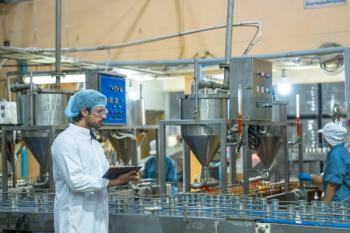
Best of the Week: The Legacy of Charles Kenneth Mann, Soil Spectroscopy, Magma Storage
Key Takeaways
- Charles Kenneth Mann significantly advanced Raman spectroscopy and chemometrics, establishing a legacy in analytical chemistry and mentoring future scientists.
- Combining Raman spectroscopy with machine learning enhances pesticide detection, offering a non-destructive, accurate method for identifying chemical substances.
Top articles published this week include an article about pioneering analytical chemist Charles Kenneth Mann, a tutorial about using Raman spectroscopy and machine learning for chemical monitoring, and an article about magma storage in Hawaii volcanoes.
This week, Spectroscopy published a variety of articles highlighting recent studies in several application areas, including geology, agriculture, and data analysis. Key techniques highlighted in these articles include Raman spectroscopy and mid-infrared (MIR) spectroscopy. Happy reading!
Charles Kenneth Mann advanced Raman spectroscopy and chemometrics, enhancing quantitative spectroscopic analysis and establishing Florida State University (FSU)'s analytical chemistry program. His research transitioned from electroanalytical chemistry to Raman spectroscopy, addressing challenges in data interpretation and instrumental limitations. Mann authored over 100 publications, mentored numerous students, and contributed to standardizing Raman spectroscopy methods (1). His legacy continues through the Charles Mann Award for Applied Raman Spectroscopy and FSU's dedicated laboratory (1). In this “Icons of Spectroscopy” column, Spectroscopy executive editor Jerome Workman, Jr. explores Mann’s life and career, highlighting some of the most important accomplishments Mann achieved in Raman spectroscopy and chemometrics.
Raman spectroscopy combined with machine learning enhances pesticide detection, offering a fast, non-destructive method for identifying chemical substances with high accuracy. A 785-nm Raman system reduces fluorescence interference, providing clearer spectra for complex samples like pesticides, compared to 532 nm excitation (2). Random Forest (RF) classification effectively distinguishes among multiple analytes, achieving over 90% accuracy, even for closely related compounds (2). This integrated approach is applicable in food safety, environmental monitoring, and agricultural quality control, emphasizing the importance of spectral preprocessing and model validation. In this tutorial article, readers will learn practical steps in spectral acquisition, spectral comparison across wavelengths, data preprocessing, and implementing machine learning models for real-world chemical monitoring (2).
The Gambia is investing in soil spectroscopy to improve agricultural productivity and economic stability through evidence-based decision-making in crop production, policy, and land restoration. A mid-infrared (MIR) soil spectroscopy laboratory at the National Agricultural Research Institute (Banjul, Gambia) enables rapid, cost-effective soil diagnostics, enhancing soil management precision and efficiency (3). The African Imaging Spectral Network supports sustainable development by applying spectral imaging to address environmental, agricultural, and medical challenges across Africa (3). The Gambia's efforts aim to optimize land management, empower local farmers, and foster a sustainable agricultural economy, reducing reliance on external consultants (3). What is happening in The Gambia is indicative of a larger trend in Africa to revitalize and improve agricultural practices.
Raman spectroscopy and seismological data revealed magma storage depths change as Hawaiian volcanoes age, shifting from shallow to deeper mantle storage. The Moho boundary significantly influences magma evolution in aging volcanoes, controlling melt stagnation as melt flux decreases (4). Seismic data corroborated the study's findings, refining models of crustal thickness and seismic wave behavior beneath Hawaiian volcanoes (4). Insights from this research could improve volcanic hazard assessments for older Hawaiian volcanoes with deeper, less accessible magma bodies (4). In this news article, we highlight this study, and how it reveals that as Hawaiian volcanoes evolve, their magma storage shifts from shallow crustal reservoirs to deeper mantle zones, offering critical insights into volcanic behavior and future hazard potential.
Spectroscopy magazine is inviting submissions for its 2025–2026 New Product Review, calling on scientists, engineers, and developers to showcase innovative spectroscopy tools. The initiative seeks new products in Raman, infrared (IR)/near-infrared (NIR)/mid-infrared (MIR) spectroscopy, hyperspectral imaging, and spectroscopy software (5). Whether compact devices or artificial intelligence (AI)-powered platforms, the goal is to highlight technologies advancing research and industry applications from materials science and pharma to food safety and environmental monitoring (5). Selected products will gain global visibility, reach key decision-makers, and receive editorial recognition for technical innovation. Submissions are open now for those pushing the boundaries of sensitivity, usability, and application in the spectroscopy field.
References
- Workman, Jr., J. Illuminating Mixtures: The Life and Legacy of Charles Kenneth Mann, Analytical Chemist and Raman Spectroscopy Pioneer. Spectroscopy. Available at:
https://www.spectroscopyonline.com/view/illuminating-mixtures-the-life-and-legacy-of-charles-kenneth-mann-analytical-chemist-and-raman-spectroscopy-pioneer (accessed 2025-08-06). - Workman, Jr., J. Mini-Tutorial: Raman Fingerprinting and Machine Learning Classification of Pesticides Using a Custom 785 nm Instrument. Spectroscopy. Available at:
https://www.spectroscopyonline.com/view/mini-tutorial-raman-fingerprinting-and-machine-learning-classification-of-pesticides-using-a-custom-785-nm-instrument (accessed 2025-08-06). - Wetzel, W. How the Advancement of Soil Spectroscopy is Improving Agriculture in The Gambia. Spectroscopy. Available at:
https://www.spectroscopyonline.com/view/how-the-advancement-of-soil-spectroscopy-is-improving-agriculture-in-the-gambia (accessed 2025-08-06). - Wetzel, W. New Study Reveals How Hawaiian Magma Storage Deepens with Volcano Evolution. Spectroscopy. Available at:
https://www.spectroscopyonline.com/view/new-study-reveals-how-hawaiian-magma-storage-deepens-with-volcano-evolution (accessed 2025-08-06). - Hroncich, C. Showcase Your Spectroscopy Innovation: Submit Your Product Today! Spectroscopy. Available at:
https://www.spectroscopyonline.com/view/showcase-your-spectroscopy-innovation-submit-your-product-today- (accessed 2025-08-06).
Newsletter
Get essential updates on the latest spectroscopy technologies, regulatory standards, and best practices—subscribe today to Spectroscopy.





